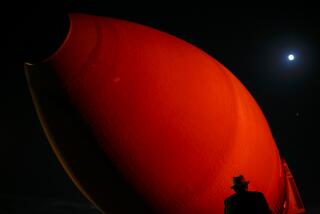Oregon Bound
- Share via
Long Beach’s Spruce Goose is being carved up to be shipped piece by piece to its new location in Oregon. The world’s largest plane, built by the late billionaire Howard Hughes between 1942 and 1946 and flown only once, will be reassembled and displayed as the centerpiece of the new Evergreen AirVenture Museum in McMinnville. The wooden plane is credited with contributing to the development of jumbo aircraft with large lift capabilities.
Transport
Overland transport: About 10 trucks will be needed to carry parts, including propellers and engines, on Interstate 5. Customized cradles have been built to house the parts, and most sections will be encased in shrink-wrap plastic for protection. Late October.
Ocean transport: A barge carrying the fuselage, wings and tail section will travel the 1,024 miles from Long Beach to Oregon on a journey lasting several weeks. In Portland, sections will be transferred to smaller barges for the trip along the Willamette River to McMinnville, arriving in late October.
Disassembly
Here is an approximate schedule for dismantling the craft:
1) Propellers and engines: Eight 800-pound propellers were disassembled and eight 28-cylinder, 3,000-horsepower Pratt & Whitney engines were removed in August.
2) Tail cone, pontoons, wingtips, flaps, elevator, rudder and ailerons: These were removed in August, including flaps weighing 2,050 pounds each and 1,400-pound ailerons.
3) Stabilizer and wings: The wings pose the greatest challenge during disassembly. Weighing 45,000 pounds each and almost 159 feet in length, they house a multitude of cables, hydraulic control systems and fuel tanks that were to be disconnected in late September.
4) Fuselage: Transported by barge to Oregon.
History
Construction: Because of wartime shortages, the government required that the craft be made of nonessential materials. So Hughes built his flying boat of wood, mostly birch. The plane never went into production because the war ended before his prototype was completed.
The flight: The first and only flight took place Nov. 2, 1947, over Los Angeles Harbor, when Hughes, who was piloting the plane, surprised thousands of people who had come to see the craft taxi on the water. In the one-minute flight, the plane covered about a mile at an altitude of about 70 feet.
Storage: Until Hughes’ death in 1976, the Spruce Goose received regular maintenance--it could be flown on 30 day’s notice--and was kept in a climate-controlled hangar. In 1982, the plane was moved to a specially constructed dome next to the Queen Mary ocean liner.
Specifications
Wing area: 11,430 square feet
Total length: 218 feet, 6 inches
Total height: 79 feet, 3 inches
Hull: 25 feet wide, 30 feet high
Tail span: 113 feet
Gross weight: 300,000 pounds
Payload: 130,000 pounds (or about 750 troops)
Fuel capacity: 14,000 gallons
Power: 24,000 horsepower
Speed: Top speed 218 m.p.h., cruising speed of 175 m.p.h.
Range: 3,500 miles
Propellers: Blades make a circle 17 feet, 2 inches in diameter; four inboard propellers are reversible.
Sources: Evergreen AirVenture Museum; “Milestones of Aviation: Smithsonian Institution National Air and Space Museum”; “The Guinness Book of Aircraft: Records, Facts and Feats.”
More to Read
Sign up for The Wild
We’ll help you find the best places to hike, bike and run, as well as the perfect silent spots for meditation and yoga.
You may occasionally receive promotional content from the Los Angeles Times.






